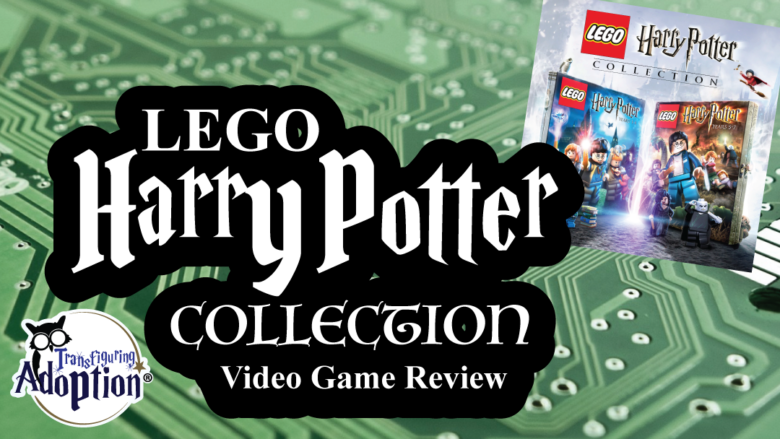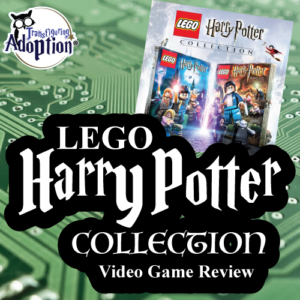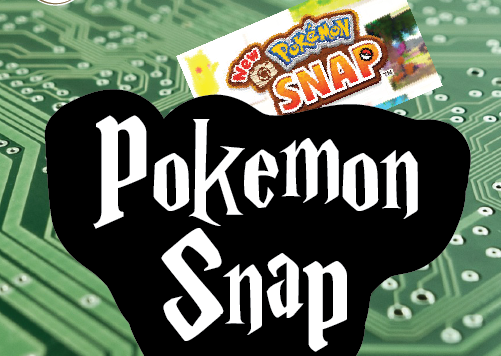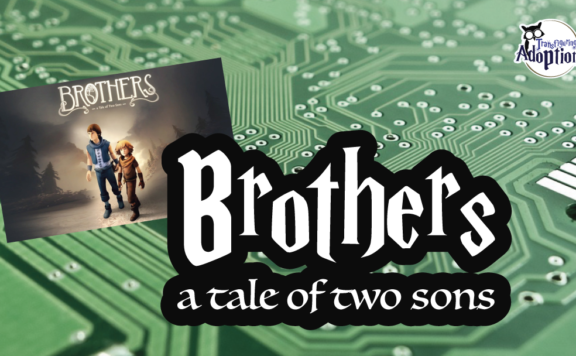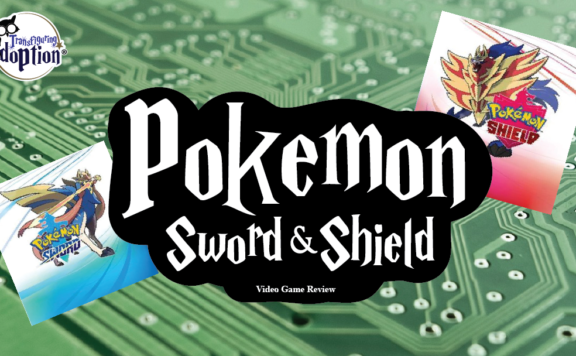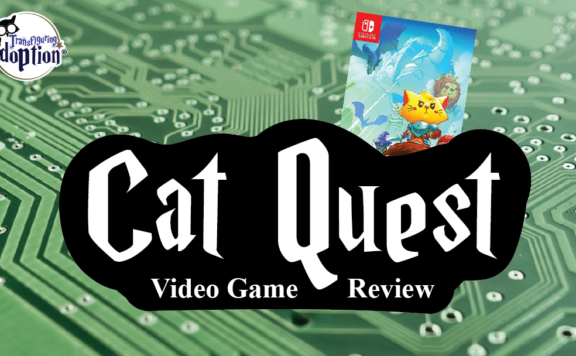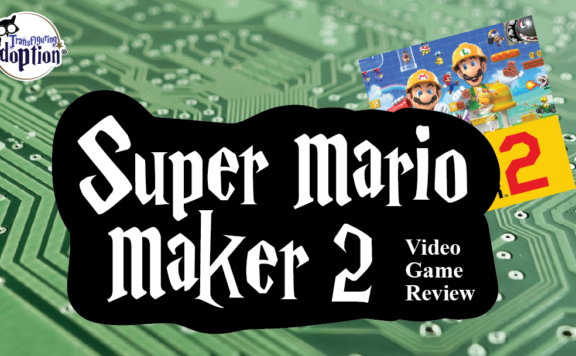[Download PDF Guide]
Grade:
Transfiguring Adoption awarded this game 4 Hoots out of 5 based on how useful it will be for a foster/adoptive family. [Learn more about our Hoot grading system here]
Movie Info:
-
Rating: E- Everyone 10+ (Cartoon Violence, Crude Humor)
-
Genre: Puzzle, Action-Adventure
-
Platform(s): Playstation 4, Nintendo Switch, Xbox One
-
Studio: TT Games, Warner Bros. Interactive Entertainment
From the Cover of Lego Harry Potter Collection by TT Games:
“The LEGO® Harry Potter™ Collection brings LEGO® Harry Potter™: Years 1-4 and LEGO® Harry Potter™: Years 5-7 remastered! This compilation unites the creative prowess of LEGO and the expansive world of Harry Potter, with an exciting journey full of spell-casting, potion-making, puzzle-solving, lessons, dueling and much more for players of all ages to enjoy.”
Transfiguring Adoption’s Overview:
If you’ve never tried one of the LEGO video games- you’re missing out. They have versions now for pretty much any popular franchise from Star Wars, to Marvel, to Ninjago to, of course, Harry Potter! In addition to re-telling these familiar stories in a hilarious fashion, the game controls are incredibly easy to pick up, even for a young child or non-gamer. The game also provides many opportunities for cooperative play and could be a fun one for you as parents to jump in on! The best part of this feature? Selecting 1-player or 2-player doesn’t lock you into that mode for the entire game. The 2nd player can jump in or out as they please (when this happens player 1 just takes over control of all the LEGO characters in play at the time). This means that if a kiddo has started playing the game alone and you want to join them for a level or two, you can, without forcing them to start over.
Technically LEGO Harry Potter is made up of two different games, broken up into Years 1-4 and Years 5-7. However, as it’s been re-released for new consoles like The Switch and PlayStation 4, they’re bundled together as The LEGO Harry Potter Collection, containing both games. Because the games are so similar in gameplay and structure, this review covers both of them together. The game is rated 10+ but given the ease of play and limited violence (they’re cartoon LEGO bricks, the worst that can happen is they break and are put back together) I’d say it’s probably okay for a slightly younger crowd- especially if they’ve already read/watched Harry Potter, provided they’re old enough to work a controller and utilize basic problem-solving skills. That said, however, I would say that the gameplay gets harder and storyline slightly darker as the years progress so 1-4 might be more appropriate for younger children.
While not required, at least some knowledge of the basic story of Harry Potter would be ideal before playing the game. They do provide some story recap scenes, but these are just brief clips of the highlights reenacted by the LEGO characters in mime. As a lifelong fan of Harry Potter personally, I love the way this game has hidden details and fun references to the Wizarding World.
** Spoilers Could Be Ahead **
How Is This Relevant To Adoption & Foster Care?
This game doesn’t specifically address foster care or adoption, other than in the brief references to the source material of Harry Potter. Anyone familiar with the story of course knows that Harry’s parents died, and he was placed in the care of his Aunt and Uncle (though looking at the game’s coverage of these events, that is not particularly clear). However the franchise often appeals to children from these backgrounds because they can relate to Harry’s parental loss and desire to create a ‘found family’ of his own.
This game is also a great way to let kids with backgrounds of trauma experience the story and characters without having all of the intense triggers and content that are present in the books and movies. While there are a fair number of cautionary points listed below, they are mostly very minor due to the fact that everything in the game is built out of LEGO bricks and therefore fairly unrealistic. The game also takes on a primarily humorous tone so a lot of things that might be scary or heavy in the books are funny instead. It’s also a GREAT game for cooperative play because it’s easy to learn and parents don’t need to have any gaming experience to be able to figure it out. And there are a lot of opportunities for problem solving and teamwork, so it works a great bonding activity!
Discussion Points:
- Teamwork
Teamwork is a big strategy during the game. There are a number of times when it takes two characters to complete a task such as reaching a tall ledge or levitating something heavy. There are also ‘student in peril’ side quests throughout the game where you are rewarded for helping fellow Hogwarts students get out of troubling situations they’ve gotten stuck in, such as being trapped in spider webs or bullied by other students. This can be a great opportunity to talk about the merits of helping others and the importance of working together in order to accomplish goals.
- Utilizing individual strengths
Throughout the game there are a number of different puzzles to solve, and they require different skills. Some require magical spells which are learned by most characters throughout the game, but some require special abilities. For example, there are some levers that need to be pulled by a strong character like Hagrid. Other times, you need to dig in the dirt which can only be done by someone with a pet or herbology skills. There are a variety of these puzzles in every level and to unlock all of the secrets and side quests you’ll need a team made up of characters with all the different types of skills. This can be a great learning experience to talk to kids about. We all have our different strengths and skills we bring to a group, but it usually takes all of us working together to accomplish a task.
- Problem Solving
The LEGO games are primarily puzzle-focused; which means that rather than fighting bad guys you’re trying to figure out how to solve various puzzles in order to progress in the game. Even the fighting sections are set up as puzzles requiring you to match colors and shapes in order to fire your spells at opponents. This can lend itself to being a great learning opportunity and a way to talk to kiddos about the different strategies involved in figuring out how to approach a problem and work on coping skills to deal with frustration that might arise when the solutions don’t come easily. Because kids from a background of trauma have often spent their lives in a constant fight-or-flight mode, they are used to needing to think quickly to figure out the best course of action to survive. Because of this their brains aren’t necessarily as good at the skill of being able to slow down, think things through, and try different approaches until reaching a solution. This game can be a great way to work on building those skills together within a fun activity.
Cautionary Points:
- Can ‘attack’ fellow LEGO people/animals
During periods of free gameplay you are able to shoot spells at anything or anyone on screen. Sometimes these spells hit other characters or animals and they respond by making an exclamation and jumping. It’s also possible to spontaneously levitate other players but this doesn’t seem to cause them any harm. During free-play you also have the option to play as a ‘dark wizard’ character such as Lucius Malfoy or even Voldemort (and to unlock all of the secret collectibles it’s actually required at times). While you are playing as a dark wizard you have different spells available including Avada Kedavra (the killing curse) and Crucio (torture spell) which you can cast at other characters causing them to instantly break apart or cry out in pain.
- Allusions to abuse by caregivers.
Those who are familiar with the story of Harry Potter will know that Harry is sent to live with his Aunt and Uncle after his parents die and they do not take very good care of him. He is forced to live in the cupboard under the stairs and is frequently verbally berated and knocked around by his aunt, uncle, and cousin. While none of this is shown in great detail, there is a speed reenactment of Harry’s childhood and we do see his cupboard, several scenes where Mr. and Mrs. Dursley have angry expressions and seem to be yelling at him, bars being put on his window, etc. So while it’s not particularly noteworthy on its own, it’s something to be aware of, especially if kids know the story.
- Cartoon violence
There are a number of situations where there is mild cartoon violence between the LEGO characters. These follow the adventures Harry and his friends encounter during the books such as a troll attack, giant spiders, a basilisk, etc. There are also times where characters cast spells at one another. Characters ‘die’ when they lose all of their hearts. However when this happens, they merely break into pieces, lose some of their collected studs and reappear back as one piece a moment later.
- Some Scary Content
There are frequent appearances by LEGO versions of snakes, spiders, and hornets which might frighten children who have fears of these creatures. Voldemort appears in a number of scenes and he sometimes makes scary faces. There’s a scene with Fluffy, Hagrid’s three-headed dog and while the LEGO dog doesn’t look particularly scary, he barks a lot, and it sounds fairly realistic and might frighten children with a fear of dogs. As with everything else these beings are all made out of LEGO bricks and are not particularly realistic. - Property destruction
One of the side tasks in the game is to collect ‘studs’ in order to buy things like additional abilities or characters. One of the main ways of earning studs is destroying everything in sight (benches, statues, etc.). Granted, everything is built out of LEGO and can be easily fixed, especially considering wizards can cast a simple ‘reparo’ charm. However, for children who have experienced their own property destroyed or have an issue with engaging in this type of destructive behavior, it may be an issue for them to engage in it during gameplay.
- Engaging in Dangerous Stunts/Behavior
Characters are able to do things like climb on roofs and jump from large heights with little consequence and often these activities are required to complete certain quests. Of course the characters are made out of LEGO bricks and at worst the break apart and are put back together. However, when children have experienced trauma, they are often more likely to engage in risk-taking behaviors, so it’s important to make sure they understand that there’s a difference between a video game and real life and know not to attempt similar stunts themselves. - Bullying
There are several instances of characters bullying one another during the game (frequently Draco and his buddies). They do things like tease and laugh at the other characters, throw mud, etc. Sometimes the victims of this behavior are seen crying or running away. Another scene requires you to chase a student around and eventually scare them with a snake to make them drop an item they’re holding (that you need). There are also a number of ‘trick spells’ that can be unlocked. These do things like cause other characters’ hair/hats to fall off, enlarge their heads, or give them carrots for noses. - Mild Cartoon Peril
Along with the dangerous stunts, there are times that the characters are in mild peril. There are frequently students caught in spiderwebs on walls or hanging from chandeliers that need to be rescued. Characters can also fall off ledges if they aren’t careful- however all that happens is that their minifigure breaks and reappears a moment later back in one piece. There are also a few levels where you are being chased down hallways by death eaters, dementors, dragons, spiders, etc. which might cause an adrenaline rush.
- ‘Sexual Content/Nudity’
Obviously, all the characters in the game are made out of LEGO bricks so none of these instances are particularly risqué. However during Diagon Alley exploration you are able to enter an occupied dressing room and there is a ‘naked’ wizard inside who hastily covers himself up when you appear. There are also a number of times, especially in later levels, where characters kiss one another. Finally there is one level in year seven where both the characters you are playing as (Harry and Ron) are wearing only their underwear and swimming in a lake. While absolutely nothing inappropriate happens, it might make some uncomfortable or inspire inappropriate conversation. These characters are both ones you can choose during free-play as well so they would be running around Hogwarts without any clothes on. All of these instances are extremely mild, but it is something to be aware of if you have kids who have been sexually abused or are sensitive to this.
- Character Death
There are a number of main characters who die in the Harry Potter series, especially in the later years. The game brushes quickly over most of these but one of note was when Dobby dies. We see Harry with a sad expression holding a piece of his body and then what appears to be a gravesite. Other characters who die include Cedric (year 4), Sirius (year 5) and Dumbledore (year 6) though all of those death scenes are more subtle.
Discussion Guide:
- Do you enjoy playing in story-mode or free-play better? Why?
Caregiver Note: The game has two major options for play. The first is ‘story-mode’ where you follow the story of Harry’s time at Hogwarts- going to classes, learning spells, and escaping from the various scrapes he and his friends get into. In this mode you’re assigned which characters to play based on what’s happening in the level. Once you’ve beaten a level for the first time, you have the option to replay it in ‘free-play’ mode. Here, you can choose your own character from all the options you have unlocked. In addition there’s more flexibility to explore Hogwarts, discover new places and complete various side quests. This is primarily a fun question to get the conversation going, but a child’s preferences might give some insight into their personalities. Some might like the structure of story-mode and their goal might be that they want to beat the game as quickly as possible and not waste time replaying levels. Other kids might like the flexibility and creativity available in free play to explore Hogwarts and the other Wizarding World locations and to collect additional special features that might help them in the game. Ultimately, if you want to beat the game to 100% completion, you have to use both modes- story and free play. This can be a time to talk about the merits of different approaches and how sometimes more structure is needed and sometimes you need flexibility. - Do you have a favorite character to play as? Why?
Caregiver Note: There are over 200 collectible characters in each half of the game. These range from our main trio of Harry, Ron, and Hermione (in about 12 different outfits each) to their friends, teachers, enemies, and random side characters that are only mentioned once. This gives a lot of choice! This is mostly just another fun question but talking about favorite characters and why they like them almost always leads to an interesting discussion! - Sometimes there is a puzzle that requires a spell you haven’t learned yet, especially early in the game. Does it frustrate you when this happens? Do you think Harry and his friends experience similar frustrations while they’re learning magic?
Caregiver Note: It can be really frustrating to see a collectible token or secret doorway that you can’t quite get to because it requires more advanced magic. In the game you learn additional spells with each year, just like Harry and his friends do at Hogwarts. But this means that not everything in a level is unlockable when you play it through the first time and to completely unlock everything in the game you have to go back and replay all the levels after you’ve learned all of the required magic spells. This, however, mimics some situations in the real world- maybe you can’t reach a high shelf because you aren’t tall enough yet, or you can’t read the book you want to because you haven’t learned enough reading skills yet. However, once you learn the more advanced skills you can come back and do things that you previously could not. It may also help to ease frustration to talk about how Harry and his friends only learned certain spells each year while they were at Hogwarts and so they couldn’t do as much magic as some of the older students which probably frustrated them at times too. Instead of being frustrated by what they can’t do, they can focus on what they CAN and use that as motivation to keep playing and getting to the higher levels to learn more so that they can unlock all of the additional abilities. - What type of puzzle do you enjoy the most? Which type do you find the most challenging?
Caregiver Note: There are many different types of puzzles in the game. One type involves stacking large LEGO pieces in a particular formation in order to climb to another area. Another is potion-making, where you’re asked to go on a scavenger hunt to locate ingredients. There are bookcases/Parseltongue spots where you have to remember a certain pattern of shapes or colors and then repeat it. Because there is so much variety there are likely some puzzles that come easier to a player and others that are more challenging. While not always true, their likes and dislikes here might correspond to which puzzles are easiest/hardest for them and could prompt some discussion on how to improve at the ones they find more challenging. - What do you do when you get stuck in the game? How do you figure out what to do next?
Caregiver Note: While the game does follow a story during initial playthrough there is a lot of room for exploration. Your characters can frequently wander around Hogwarts exploring between story levels and sometimes it’s not obvious where to go next. Each level also consists of mini puzzles so it’s not always clear exactly what needs to be done to trigger the next movement of the story. There are large blue arrows in the game directing you around Hogwarts when it’s time for glass and Nearly Headless Nick (a ghost character) lays out a trail of ‘ghost’ studs showing you the way to go. This could also be a good way to talk to children about problem solving skills and the benefits of trying different things until they figure out what works. Sometimes children (and adults!) can get easily frustrated when the solution to something isn’t immediately clear so you can also talk about ways to manage that frustration by doing breathing exercises or taking a break from the game and coming back to it with a clear mind to try again. - Are you able to follow the story during the cutscenes even though the characters don’t talk? How do they get their point across without words?
Caregiver Note: The LEGO characters in the game don’t speak at all, either during the game levels or the movie scenes. Instead they tell the story through gestures, facial expressions, and sound effects. This can be a great way to talk about alternative means of communication and ways youth can express themselves if they aren’t able to do so through words. For children who have difficulties with verbal expression they may really relate to the way that the story is told. It can also be a good way to talk to kids about how to tell what emotions others might be feeling. This is something that kids who have experienced trauma may have difficulty with so talking about how we know a character is sad based on how their face looks or that they’re angry based on the way they move. While LEGO bricks are not the most realistic comparison to real people, the added benefit is that they are using exaggerated gestures and expressions so it might make it easier to recognize if this is something a kiddo has trouble with. - Do you have a favorite spell? Do you think it would be useful in the real world?
Caregiver Note: This is mostly a fun question. There are different spells used throughout the game with effects that include making things fly, opening locks, creating light, etc. Children may choose a spell based on its usefulness in the game, a memory of the way it was used during the Harry Potter movies or books if they’ve seen/read them, or just because they like the idea of it. The important part is to talk about why they like something because this gets them sharing their thought process. Trying to imagine how different spells might be useful in the real world could also give some insight into their personality or things they’d like to be different. Maybe if they have a fear of the dark they would like to have a Lumos spell that can create light, or maybe they like Expecto Patronum because it makes the Dementors/Scary bad guys go away. - If you could use Polyjuice Potion to be someone else for an hour, who would you choose? Why?
Caregiver Note: Sometimes in the game you have to make Polyjuice Potion which transforms you into another character in order to complete a quest. This question again is mostly one that’s light and fun but could lead to some interesting discussion depending on who they choose to be! We’ve all wondered what it would be like to be someone else at some point in our lives, so talking about who they would pick and why they would want to be that person could offer insight as to things they might like to change about themselves or experiences they might like to have. Depending on comfort level, you could choose real people like celebrities or historical figures you’d like to turn into or choose a fictional character either from the Harry Potter universe or another books/movie/video game. - Have you used any of the trick spells? How do they affect other characters?
Caregiver Note: One of the special features you can unlock within the game is ‘trick spells’. These are special spells you can buy that include a ‘tripping jinx’ and a spell to replace others’ noses with carrots. Most of them are harmless pranks but this can be a good opportunity to talk about the differences between teasing in good fun and bullying and how to know when a joke stops being funny and is hurting someone’s feelings. All kids like to joke and pull pranks on one another but it’s important to know where that fine line is and also how to tell someone else that something they think is a joke bothers you. - Have you created your own custom minifig yet? Can you show me/tell me about it?
Caregiver Note: The game is loaded with special features- another one is the ability to create your own LEGO minifigure to play as during Free play. There are a number of templates to choose from and everything can be customized from their outfit to hair color to facial expression. This gives your child the opportunity to talk about their creation and why they made the choices they did. Maybe they wanted to make one that looked like themselves or create a made-up character wearing a crazy outfit. Either way it could be a jumping off point for a fun conversation and maybe a creative activity to do together, even if you don’t play the actual game levels with them. Try asking them to make a character that represents you and see what they come up with!
About the Author: Jenn Ehlers
Jenn is a central Virginia native who received her BA in Psychology from the University of Virginia in 2012. Since then she has worked for a local mental health agency and the Department of Social Services in various capacities and has been involved in her community’s efforts to create a Trauma Informed Network. Currently Jenn works in vocational rehab and mentors youth in foster care. When she isn’t working, Jenn enjoys writing stories, anything and everything Harry Potter, and spending time with her niece and nephew.
**Transfiguring Adoption is a nonprofit organization seeking to nurture growth in foster and adoptive families by giving a HOOT about their families. Transfiguring Adoption does not intend for its reviewers nor its review to be professional, medical or legal advice. These reviews and discussion guides are intended to help parents to better be able to connect and understand their children who come from traumatic backgrounds.
